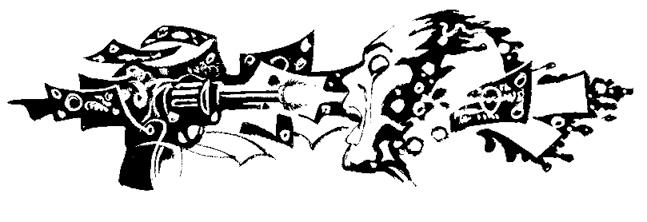
BOUNTY
In May, the first week there was one death. The second, there were four, the third, nineteen. The fourth week, 39 people were killed.
Most were shot by pistol, rifle, or shotgun. Four were killed with knives, two by meat cleavers, and one by a dinner fork worked methodically through the spinal cord. It was not the dinner fork that aroused comment but the evident fact that someone had finished his or her meal with its duplicate.
The Mayor said, “This has got to stop.”
The Governor said, “This has got to stop.”
The President, through his Secretary for Health and Welfare, said somewhat the same thing.
The Police Commissioner and Prosecuting Attorney said there would be no stone left unturned and the FBI said, regretfully, that it was a local matter.
No one ever was quite sure who was on or who was behind the Committee but the advertisement—one issue, double-page spread—had been authentic, had paid off in hard cash; within the city limits, ten thousand dollars cash for the death of anyone caught in the process of armed robbery and one hundred thousand to the estate of anyone killed while attempting to halt armed robbery.
Such an advertisement was definitely not in the public interest and every bristling aspect of the law said so. The suburban booster sheet that had originally printed the ad promised not to do it again.
But this kept on and over the weeks and a few square miles—cities are crowded in their sprawl—over two million dollars had been paid without quibble and sometimes at night secretly, because Internal Revenue considers no income tainted. Things became complex when three policemen in varying parts of the city incautiously let their off-duty holstered guns be spotted by strangers or by fellow customers in a store. Too rapidly for the innocent police to identify themselves, a swirl of action, and three men were dead—all painlessly. Further executions were eliminated by the flaunting of police badges in public, with consequent reduction of vice squad arrests.
By July, pedestrians after dark carried large flashlights and in business districts made no abrupt movements. Vigilante groups at first hired doddering men and women to hobble decoy in certain areas; later, as techniques became perfected, heavily armed and suicidal senior citizens acted as independent Q-ships and frail-looking women waited endlessly at bus stops or lugged expensive-looking packages back and forth across parking lots. Behind grocery store partitions and drycleaner’s curtains sat or lazed volunteer part-time, full-time, and nighttime guards.
By September four hundred plus had been killed. Court dockets were clogged with scheduled homicide trials while the incidence of armed and unarmed robberies slid almost to zero. Police are forbidden to accept rewards but cabin cruisers, summer cottages, snomobiles and trips to Hawaii can be bought and paid for by midnight cash. No one dared to resist arrest.
Then the reward system was extended outstate where rates of crime had been increasing. The 11 by 14 advertising was traced to a small shop on Center Street, but the owner had moved to Winnipeg. The first to die—four men, two of them brothers—tried to hold up an outstate bank. Their dress oxfords clashed with their hunting costumes and the bank manager, one teller, and two customers were waiting.
Armed and unarmed robbery died out together with some three hundred probably-guilty persons but the Governor at last appealed for federal aid, pleading his entire legal system was breaking down. Officials of the three bordering states and Canada on the north were equally interested in his plea. Nothing was accomplished at a series of top level conferences.
In sudden succession the three bordering states had their own operating Committees, apparently unconnected with the first. Then other cities some miles away and then other states. A reliable estimate of reward money earned and paid out ran to half a billion dollars before the object was attained, as the reward system spread totally east and totally west of the Mississippi.
In New York City proper, children began to be seen playing in Central Park at dusk and even after.
With all rumors dissected, with duplicate reports discounted, and counting the death-welcoming onslaughts of unarmed applicants for free hundred-thousand-dollar survivor benefits, over the next three years the casualty list was somewhat less than automotive deaths in 1934. The fourth year there was a presidential election.
The winning candidate ran on a Law and Order platform. Two Secret Service men on inauguration day, while mingling with the gay crowd, incautiously let their .44 Magnums be seen and were dismembered quite quickly. After the first session of Congress a Federal ban on portable weapons was passed. This included weapons carried by law enforcement officers. Scotland Yard loaned fourteen quarterstaff specialists to the FBI police school and some seventeen thousand homicide cases were nolle prossed.
Montessori kindergartens expanded curricula to include judo and karate and General Motors phased out its Soapbox Derby and awarded black belts to the most worthy. Popular Science & Mechanix Illustrated ran a series on car-spring crossbows. Deer became an everyday sight and somewhat of a nuisance in the streets of Saginaw and Sebewaing.
At present the House Un-American Activities Committee is investigating the skyrocketing import of Japanese chemical sets for adults.